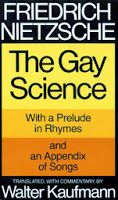
In response to my previous post about dolphin babies and synthetic biology, Professor Rubin offered a thoughtful comment — here’s an excerpt:
A wonderful, thought-provoking post! I suppose that “taking these speculative and transgressive fantasies about science too seriously” would mean at least failing to look critically at whether they are even possible, given what we now know and are able to do. That is indeed an important task, although it is also a moving target–the fantasies of a few decades ago have been known to become realities. To that extent, taking them “too seriously” might also mean failing to distinguish between the monstrous and the useful. That is to say, one would take the fantasies too seriously if one accepted at face value the supposed non-monstrousness of the goal being advanced or (to put it another way) if one accepted the creation of monsters as something ethically desirable.
I’m grateful for Charlie’s comment — you should read the whole thing — not least because it gives me the delightful opportunity to pontificate a bit more on the moral implications of this sort of monstrosity.
There are indeed a number of technologies that are on the border of the monstrous and the useful. And, just as many things that decades ago were considered technically fantastic but are now realities, there are many practices that were once considered morally “fantastic” (i.e., monstrous) but are now widely accepted, such as in vitro fertilization (IVF, the technique for producing so-called “test-tube babies”) or organ transplantation. (Though these technologies have become broadly accepted by society, neither are by any means wholly uncontroversial or devoid of moral implications—many still find IVF morally problematic, and proposals to legalize the sale of organs for transplantation are a matter of ongoing controversy.) Scientists sometimes make what was once monstrous seem acceptable, but largely through showing that what is monstrous can be useful — meaning that a seemingly monstrous practice has some actual benefits, and that whatever risks it poses are relatively limited. This is the refrain often heard in debates over assisted reproductive technologies, that though IVF was once considered monstrous, after forty years and millions of babies provided more or less safely for infertile couples, the practice is, advocates claim, now largely unobjectionable.
To take a biotechnological example that is in some respects analogous to Ai Hasegawa’s dolphin-baby project, consider the possibility of growing human organs in pigs or other animals. There is something monstrous about human-pig chimeras — creating them violates taboos relating to bodily integrity and the immiscibility of species — but there is something very useful about having a ready supply of kidneys or pancreases, and so human-pig chimeras are a logical extension of Baconian (forgive the pun) science’s effort to relieve man’s estate and all that. Whether human-pig chimeras or any other useful but monstrous innovations of Baconian science are ethically acceptable is just the sort of question that deserves serious attention.
 |
| reasonable |
Unlike IVF or human-pig chimeras, it seems very difficult to imagine a situation in which ordinary people could see the birthing and eating of dolphins as useful, that is, as conducive to securing the possession or enjoyment of anything a rational person might consider good, such as health. Though Hasegawa does offer a justification for the project with a few bromides about overpopulation and saving endangered species, it goes without saying that the gestation and consumption of dolphins by human beings could hardly contribute to ameliorating these perceived problems. In her description of the project, Hasegawa states that the gestation of dolphins could “satisfy our demands for nutrition and childbirth” and poses the question “Would raising this animal as a child change its value so drastically that we would be unable to consume it because it would be imbued with the love of motherhood?” As for nutrition, it is obviously patently irrational to gestate your meal — the energy required for such a project far exceeds the nutritional value of the “product.”
More interesting is the idea that giving birth to a non-human animal could satisfy a woman’s demand for “childbirth” and that the act of gestating an animal could “change its value” and imbue it “with the love of motherhood.” Such statements indicate that this project does not really aim at helping people secure the enjoyment of things that they currently value, but at transforming values by questioning the relationship between motherhood’s natural purpose and context and its value.
Hasegawa’s project seems comparable to Jonathan Swift’s “Modest Proposal” for solving hunger and overpopulation by eating babies, which was a satire of amoral rationalistic utilitarianism. But one hardly gets an impression of an excess of rationality in Hasegawa’s proposal. The video portraying her giving birth to a dolphin might be seen as creepy or silly, but its creepiness and silliness comes from an absurd misapplication of parental sentiment, not the absurd absence of parental sentiment in Swift’s satire.
Hasegawa’s project is not the useful science of Bacon, but the “gay science” of Friedrich Nietzsche, who argued that science (including both the natural and social sciences) had a tendency to undermine moral values as it studied them. In his typical overwrought style, Nietzsche prophesied that after scientists of various kinds completed their studies of the history, psychology, and diversity of moral values, then
the most insidious question of all would emerge into the foreground: whether science can furnish goals of action after it has proved that it can take such goals away and annihilate them; and then experimentation would be in order that would allow every kind of heroism to find satisfaction—centuries of experimentation that might eclipse all the great projects and sacrifices of history to date. So far, science has not yet built its cyclopic buildings; but the time for that, too, will come.
Hasegawa would seem to be one of those heroic experimenters who seeks to build new values out of the rubble of exploded notions of the good life (in this case, motherhood). The destroyers of these values have been those legions of industrious scientists over the twentieth century — including social scientists, many of whom have been highly influenced by Nietzsche — who have sought to explain or explain away moral values in terms of power or greed or evolutionary drives.
 |
| not reasonable |
Sensible people should reject both halves of Nietzsche’s prophecy about the future of science. We should reject the premise that science has an inherent tendency to destroy moral values on both pragmatic and theoretical grounds. Pragmatically, it is unwise to give public credence to the idea that science undermines morality, since, whatever the real validity of that proposition, if it is accepted it could become a self-fulfilling prophecy — believing that science refutes morality could lead to the abandonment of morality. Theoretically, accepting the idea that science can refute morality seems to lead directly to relativism or nihilism. For if science qua science (and not overconfident deviations from science like scientism that lack the epistemic rigor that science must necessarily strive for) refutes morality, then there could be no true moral knowledge (for if moral knowledge were true, then it could not truly be refuted by science).
If we reject that premise, then there would be no need for the simply monstrous projects aimed at inventing or transforming values — Nietzsche’s “most insidious question” never emerges. Bacon’s science and its fruits often call for us to balance the moral need to avoid the monstrous with the moral demand to pursue the useful, and we will all surely continue to face dilemmas of how to balance these moral demands. But we need not worry about those who claim that the progress of science alters the nature of morality itself.
